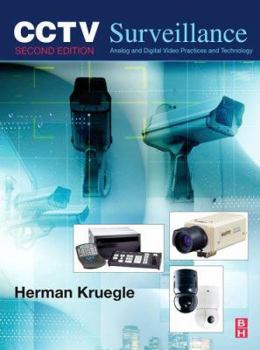Cctv Surveillance: Video Practices and Technology
Select Format
Select Condition 
Book Overview
This revision of the classic book on CCTV technology, CCTV Surveillance, provides a comprehensive examination of CCTV, covering the applications of various systems, how to design and install a system, and how to choose the right hardware. Taking into account the ever-changing advances in technology using digital techniques and the Internet, CCTV Surveillance, Second Edition, is completely updated with the recent advancements in digital cameras and digital recorders, remote monitoring via the Internet, and CCTV integration with other security systems. Continuing in the celebrated tradition of the first edition, the second edition is written to serve as a useful resource for the end-user as well as the technical practitioner. Each chapter begins with an overview, and presents the latest information on the relevant equipment, describing the characteristics, features and application of each device. Coverage of aging or obsolete technology is reduced to a historical perspective, and eight brand new chapters cover digital video technology, multiplexers, integrated camera-lens-housing, smart domes, and rapid deployment CCTV systems.
Format:Hardcover
Language:English
ISBN:0750677686
ISBN13:9780750677684
Release Date:December 2006
Publisher:Butterworth-Heinemann
Length:672 Pages
Weight:4.55 lbs.
Dimensions:1.4" x 8.7" x 11.2"
Customer Reviews
1 rating
Still a good, useful book.
Published by Thriftbooks.com User , 20 years ago
First, I'll agree that this book is outdated. It was written on the edge of the Dot Com boom, when the entire CCTV industry was still based on analog equipment. This is why I am not giving it the full 5 stars. Critique of this book: The previous reviewer complains about the book not discussing digital video servers - but in chapter 8 this book DOES talk about storing video on hard drives and on optical disks. In 1995 optical disks were the most cost effective method of storing video. The previous reviewer also complains that this book doesn't describe Frames and Fields, and that too is a valid complaint, but one that should not be held against this book due to the time it was published. This book is meant as an overview for the CCTV professional just starting out in the CCTV industry. It is not meant to be an engineer's handbook on how PAL or NTSC video is constructed, and it does not go into the mathematics of video. Kruegle was not concerned with explaining video Frames or Fields because these concepts were only of interest to CCTV design engineers. Frames and Fields only became important to the layman when explaining to the layman about storage of video in a digital format. Video servers were not mentioned because in 1995 video servers were rare and costly. In 1995 when this book was published, hard drive storage cost 23 to 24 cents per megabyte. Today (Feb 2005) hard drive storage costs 6 to 7 cents per 100 megabytes. A video storage system that uses 16 cameras would need to store 480 images a second for real-time video. If the average image size were 9 KB, then one day of storage would require 373 GB of storage. In 1995 this storage would have required two hundred twenty seven top of the line 1.6 GB hard drives, and the cost of the hard drives alone would have been over 85 thousand dollars! Compare this to a single 400 GB hard drive today, which would cost a mere $200. It's no wonder that Kruegle only touched on digital storage. He mentions that the CCTV industry will advance in the digital realm within the "next decade", and boy was he right! But at the time of his writing, all CCTV systems were analog based, and centrally located. Distributed Ethernet based CCTV systems were not practical. (Many people today would argue that they are still not practical.) So what's so good about this book? Why in the world would anyone want to have this outdated book on his or her bookshelf? Because the basic concepts of CCTV are still valid! Also because no other book has been written to present such a well thought out overview of CCTV! This book describes the role of CCTV in protecting property, people and assets, it describes the limitations of CCTV in general, it discusses the lighting needed, and exactly how to determine what lens to use in which situation. It has one of the best descriptions of how to calculate field of view from focal length that I've ever seen. (Recording methods may have changed, but lens technolo






